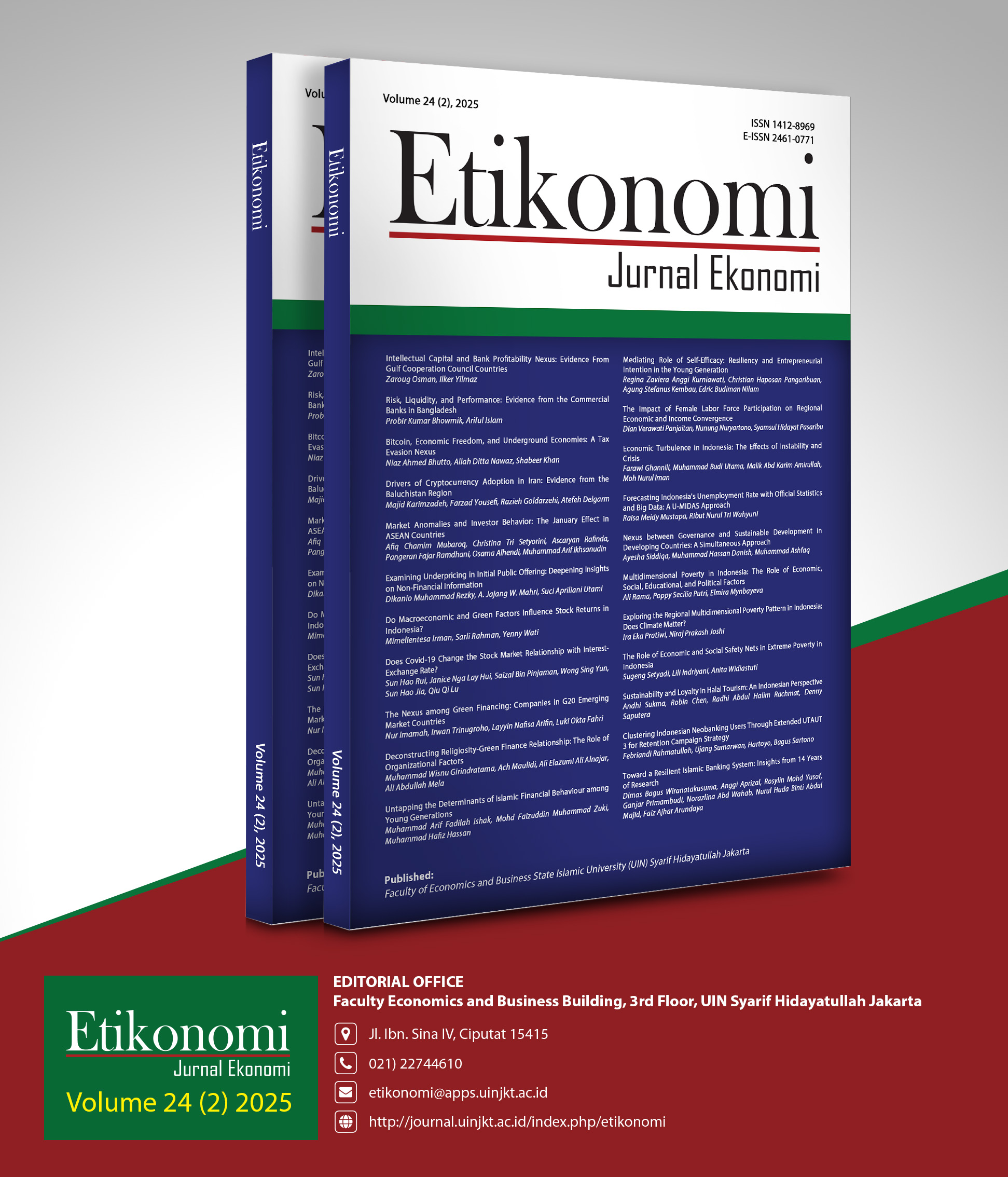Untapping the Determinants of Islamic Financial Behaviour among Young Generations
DOI:
https://doi.org/10.15408/etk.v24i2.43908Keywords:
Islamic financial behaviour, Islamic financial literacy, parental financial socialization, financial self-efficacy, young generationsAbstract
Research originality: The originality of this research lies in its integrated examination of psychological, social, and educational determinants of Islamic financial behaviour within a localized Malaysian context.
Research objectives: Grounded in the Theory of Planned Behaviour, the research investigates how Islamic financial literacy, financial risk attitude, parental financial socialization, and financial self-efficacy influence financial behaviour.
Research methods: A structured questionnaire was distributed to 358 respondents aged 18 to 30, and the data were analyzed using covariance-based Structural Equation Modelling (CB-SEM).
Empirical result: The study reveals two significant findings: parental financial socialization and financial self-efficacy strongly predict Islamic financial behaviour, while financial literacy and risk attitude show insignificant relationships.
Implications: Policymakers should embed Islamic financial literacy in national youth programs, educators must integrate hands-on financial training into curricula, and Islamic finance providers are encouraged to offer youth-friendly, Shariah-compliant products supported by educational outreach and family-involved financial awareness initiatives.
JEL Classification: D10, D14, D91, G41
Downloads
References
Albaity, M., & Rahman, M. (2019). The Intention to Use Islamic Banking: An Exploratory Study to Measure Islamic Financial Literacy. International Journal of Emerging Markets, 14(5), 988–1012. https://doi.org/10.1108/IJOEM-05-2018-0218.
Ali, M., Raza, S. A., & Puah, C.-H. (2015). Factors Affecting Intention to Use Islamic Personal Financing in Pakistan: Evidence from the Modified TRA Model. MPRA Paper No. 66023.
Antara, P. M., Musa, R., & Hassan, F. (2016). Bridging Islamic Financial Literacy and Halal Literacy: The Way Forward in Halal Ecosystem. Procedia Economics and Finance, 37, 196–202. https://doi.org/10.1016/s2212-5671(16)30113-7.
Bandura, A. (1986). The Explanatory and Predictive Scope of Self-Efficacy Theory. Journal of Social and Clinical Psychology, 4(3), 359–373. https://doi.org/10.1521/jscp.1986.4.3.359.
Bandura, A., Adams, N. E., & Beyer, J. (1977). Cognitive Processes Mediating Behavioral Change. Journal of Personality and Social Psychology, 35(3), 125–139. https://doi.org/10.1037/0022-3514.35.3.125.
Cameron, M. P., Calderwood, R., Cox, A., Lim, S., & Yamaoka, M. (2014). Factors Associated with Financial Literacy Among High School Students in New Zealand. International Review of Economics Education, 16, 12–21. https://doi.org/10.1016/j.iree.2014.07.006.
Chin, W. W., & Newsted, P. R. (1999). Structural Equation Modeling Analysis with Small Samples Using Partial Least Squares. In Hoyle, R. H. (Ed.), Statistical Strategies for Small Sample Research. New York: Sage Publications.
Danes, S., & Haberman, H. (2007). Teen Financial Knowledge, Self-Efficacy, and Behavior: A Gendered View. Journal of Financial Counseling and Planning, 18(2), 48-60.
Dew, J., & Xiao, J. J. (2013). The Financial Management Behavior Scale: Development and Validation. Journal of Financial Counseling and Planning, 22(1), 43-60.
Ergün, T. (2024). Impact of Islamic Financial Attitude on Islamic Financial Behaviour among Youth in Turkey: A Moderated Mediation Model. Turkish Journal of Islamic Economics, 12(1), 176–199. https://doi.org/10.26414/A4162.
Farrell, L., Fry, T. R. L., & Risse, L. (2016). The Significance of Financial Self-Efficacy in Explaining Women’s Personal Finance Behaviour. Journal of Economic Psychology, 54, 85–99. https://doi.org/10.1016/j.joep.2015.07.001.
Fernandes, P. O., Veloso, C. M., Magueta, D., & Ribeiro, H. (2017). The Effects of Customer Satisfaction, Service Quality and Perceived Value on Behavioural Intentions in Retail Industry. Proceeding of the 23rd International Scientific Conference on Economic and Social Development.
Fornell, C., & Larcker, D. F. (1981). Evaluating Structural Equation Models with Unobservable Variables and Measurement Error. Journal of Marketing Research, 18(1), 39-50. https://doi.org/10.2307/3151312.
García, J. M., & Vila, J. (2020). Financial Literacy Is Not Enough: The Role of Nudging Toward Adequate Long-Term Saving Behavior. Journal of Business Research, 112, 472–477. https://doi.org/10.1016/j.jbusres.2020.01.061.
Gerrans, P., Faff, R., & Hartnett, N. (2015). Individual Financial Risk Tolerance and The Global Financial Crisis. Accounting & Finance, 55(1), 165–185. https://doi.org/10.1111/acfi.12053.
Gerrard, P., & Barton Cunningham, J. (2003). The Diffusion of Internet Banking Among Singapore Consumers. International Journal of Bank Marketing, 21(1), 16–28. https://doi.org/10.1108/02652320310457776.
Gudmunson, C. G., & Danes, S. M. (2011). Family Financial Socialization: Theory and Critical Review. Journal of Family and Economic Issues, 32(4), 644–667. https://doi.org/10.1007/s10834-011-9275-y.
Hair, J. F., Anderson, R. E., Babin, B. J., & Black, W. C. (2010). Multivariate Data Analysis (7th ed.). New Jersey: Pearson Prentice Hall.
Henseler, J., Ringle, C. M., & Sinkovics, R. R. (2009). The Use of Partial Least Squares Path Modeling in International Marketing. In Sinkovic, R. R., & Ghauri, P. N. (Eds). New Challenges to International Marketing., 277–319. Netherlands: Emerald Publishing.
Huston, S. J. (2010). Measuring Financial Literacy. Journal of Consumer Affairs, 44(2), 296–316. https://doi.org/10.1111/j.1745-6606.2010.01170.x.
Indana, R., & Pambekti, G. T. (2022). Does Financial Attitude Mediate Relationship Between Islamic Financial Knowledge, Internal Locus of Control and Islamic Financial Behavior? Jurnal Ilmiah Ekonomi Islam, 8(3), 3599. https://doi.org/10.29040/jiei.v8i3.5644.
Jariwala, H. V. (2015). Analysis of Financial Literacy Level of Retail Individual Investors of Gujarat State and Its Effect on Investment Decision. Journal of Business & Finance Librarianship, 20(1–2), 133–158. https://doi.org/10.1080/08963568.2015.977727.
Jorgensen, B. L., & Savla, J. (2010). Financial Literacy of Young Adults: The Importance of Parental Socialization. Family Relations, 59(4), 465–478. https://doi.org/10.1111/j.1741-3729.2010.00616.x.
Kannadhasan, M. (2015). Retail Investors’ Financial Risk Tolerance and Their Risk-Taking Behaviour: The Role of Demographics as Differentiating and Classifying Factors. IIMB Management Review, 27(3), 175–184. https://doi.org/10.1016/j.iimb.2015.06.004.
Kayed, R. N., & Hassan, M. K. (2011). The Global Financial Crisis and Islamic Finance. Thunderbird International Business Review, 53(5), 551–564. https://doi.org/10.1002/tie.20434.
Keller, C., & Siegrist, M. (2006). Investing In Stocks: The Influence of Financial Risk Attitude and Values-Related Money and Stock Market Attitudes. Journal of Economic Psychology, 27(2), 285–303. https://doi.org/10.1016/j.joep.2005.07.002.
Kempson, E., Finney, A., & Poppe, C. (2017). Financial Well-Being a Conceptual Model and Preliminary Analysis. Working Paper, Oslo and Akershus University College of Applied Sciences.
Lee, M. C. (2009). Factors Influencing the Adoption of Internet Banking: An Integration Of TAM And TPB With Perceived Risk and Perceived Benefit. Electronic Commerce Research and Applications, 8(3), 130–141. https://doi.org/10.1016/j.elerap.2008.11.006.
Li, Y., Zuiker, V. S., Mendenhall, T. J., & Montalto, C. P. (2021). Parental Financial Socialization, Financial Experiences, and Financial Behaviors: Comparing Asian American and International Asian College Students. Journal of Financial Counseling and Planning, 32(1), 68–85. https://doi.org/10.1891/JFCP-19-00008.
Lown, J. M. (2011). Development and Validation of a Financial Self-Efficacy Scale. Journal of Financial Counseling and Planning, 22(2), 54-63.
Lusardi, A., & Mitchell, O. S. (2011). Financial Literacy around the World: An Overview. NBER Working Paper Series No. 17107.
Lusardi, A., & Mitchell, O. S. (2014). The Economic Importance of Financial Literacy: Theory and Evidence. Journal of Economic Literature, 52(1), 5–44. https://doi.org/10.1257/jel.52.1.5.
Mandell, L., & Klein, L. S. (2009). The Impact of Financial Literacy Education on Subsequent Financial Behavior. Journal of Financial Counseling and Planning, 20(1), 15-24.
Mathew, V., Santhosh Kumar P K, & Sanjeev M A. (2024). Financial Well-being and Its Psychological Determinants— An Emerging Country Perspective. FIIB Business Review, 13(1), 42–55. https://doi.org/10.1177/23197145221121080.
Mindra, R., & Moya, M. (2017). Financial Self-Efficacy: A Mediator in Advancing Financial Inclusion. Equality, Diversity and Inclusion: An International Journal, 36(2), 128–149. https://doi.org/10.1108/EDI-05-2016-0040.
Mohamed, N. A. (2017). Financial Socialization: A Cornerstone for Young Employees’ Financial Well-Being. Reports on Economics and Finance, 3, 15–35. https://doi.org/10.12988/ref.2017.711.
Nawi, F. A. M., Daud, W. M. N. W., Ghazali, P. L., Yazid, A. S., & Shamsuddin, Z. (2018). Islamic Financial Literacy: A Conceptualization and Proposed Measurement. International Journal of Academic Research in Business and Social Sciences, 8(12), 5061. https://doi.org/10.6007/IJARBSS/v8-i12/5061
Oladapo, I. A., Omar, N., Muda, R., & Abdurraheem, A. A. (2019). The Mediating Effect of Attitude on Customers’ Behavioural Intention to Participate in Islamic Banking: Empirical Evidence. International Journal of Financial Research, 10(5), 167. https://doi.org/10.5430/ijfr.v10n5p167.
Oquaye, M., Owusu, G. M. Y., & Bokpin, G. A. (2022). The Antecedents and Consequence of Financial Well-Being: A Survey of Parliamentarians in Ghana. Review of Behavioral Finance, 14(1), 68–90. https://doi.org/10.1108/RBF-12-2019-0169.
Pahlavi, M. R., Gusniarti, & Gultom, M. S. (2022). Influence of Financial Knowledge, Financial Self efficacy, and Locus of Control to Islamic Financial Behaviour on Generation Z in DKI Jakarta. Proceeding of the International Conference on Health Science, Green Economics, Educational Review and Technology 2022.
Potrich, A. C. G., Vieira, K. M., & Mendes-Da-Silva, W. (2016). Development of a Financial Literacy Model for University Students. Management Research Review, 39(3), 356–376. https://doi.org/10.1108/MRR-06-2014-0143.
Raut, R. K. (2020). Past Behaviour, Financial Literacy and Investment Decision-Making Process of Individual Investors. International Journal of Emerging Markets, 15(6), 1243–1263. https://doi.org/10.1108/IJOEM-07-2018-0379.
Roszkowski, M. J., & Grable, J. (2005). Estimating Risk Tolerance: The Degree of Accuracy and the Paramorphic Representations of the Estimate. Financial Counseling and Planning, 16(2), 29-47.
Sarstedt, M. (2008). A Review of Recent Approaches for Capturing Heterogeneity in Partial Least Squares Path Modelling. Journal of Modelling in Management, 3(2), 140–161. https://doi.org/10.1108/17465660810890126.
Serido, J., Shim, S., & Tang, C. (2013). A Developmental Model of Financial Capability. International Journal of Behavioral Development, 37(4), 287–297. https://doi.org/10.1177/0165025413479476.
Shim, S., Barber, B. L., Card, N. A., Xiao, J. J., & Serido, J. (2010). Financial Socialization of First-year College Students: The Roles of Parents, Work, and Education. Journal of Youth and Adolescence, 39(12), 1457–1470. https://doi.org/10.1007/s10964-009-9432-x.
Shim, S., Xiao, J. J., Barber, B. L., & Lyons, A. C. (2009). Pathways to Life Success: A Conceptual Model of Financial Well-Being for Young Adults. Journal of Applied Developmental Psychology, 30(6), 708–723. https://doi.org/10.1016/j.appdev.2009.02.003.
Sundarasen, S. D. D., Rahman, M. S., Othman, N. S., & Danaraj, J. (2016). Impact of Financial Literacy, Financial Socialization Agents, and Parental Norms on Money Management. Journal of Business Study Quarterly, 8(1), 137-153.
Susan, M. (2020). The Antecedents of Financial Literacy: A Study on College Students. International Journal of Economic Policy in Emerging Economies, 13(4), 337-343. https://doi.org/10.1504/IJEPEE.2020.109583.
Teddlie, C., & Yu, F. (2007). Mixed Methods Sampling: A Typology with Examples. Journal of Mixed Methods Research, 1(1), NP1–NP1. https://doi.org/10.1177/2345678906292430.
Downloads
Published
Issue
Section
License
Copyright (c) 2025 Muhammad Arif Fadilah Ishak, Mohd Faizuddin Muhammad Zuki, Muhammad Hafiz Hassan

This work is licensed under a Creative Commons Attribution-ShareAlike 4.0 International License.










